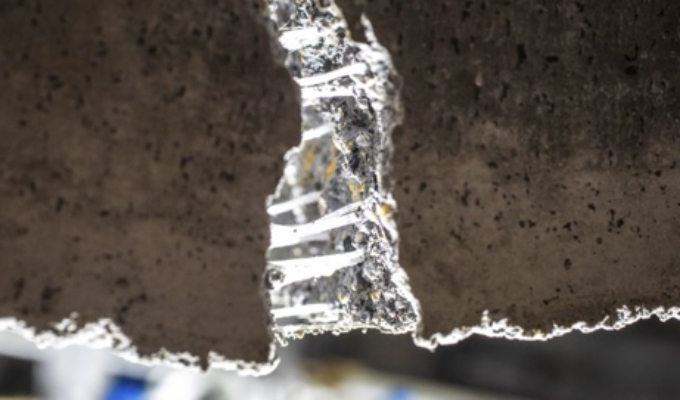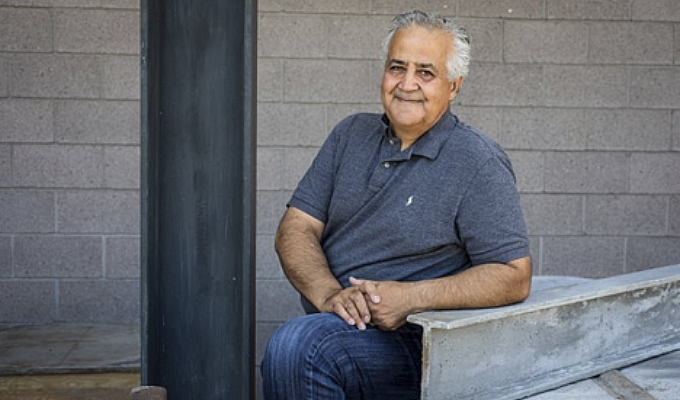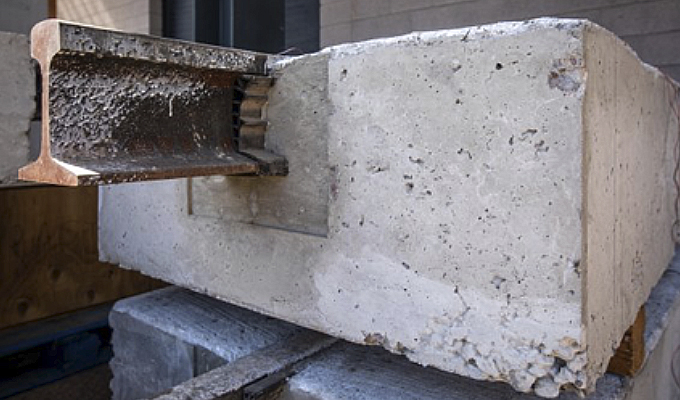“Phoenix will be a great city when it’s finished,” said a visitor in the 1950s.
An Arizona State University engineering professor is trying to promote a method of speeding up the Valley’s endless construction projects that can reduce years to months and months to weeks. Transportation experts say the economic, safety, and transit benefits could be huge.
Earlier this year, residents and businesses in south Phoenix fought against extension of the Valley’s light rail system into their neighborhood. Besides opposition to Central Avenue being cut down to two lanes from four, their other objection to the project was the 4-year construction timeline.
Construction takes time. And the bigger the project, the longer the timeline. The Big Dig in Boston—burying a freeway through the heart of the city—took 15 years. Traffic, the flow of goods and services, business conducted adjacent to worksites—it all gets disrupted. Barzin Mobasher’s magic bullet is made of fiber-reinforced concrete. Mobasher and his team have come up with a certain set of calculations engineers can use to simplify working with the material.

Annually, worldwide, 10 billion tons of concrete are used: more than one ton for every man, woman, and child on the planet. It’s the cheapest material that can be used in construction of roads, buildings, and other things.
Designs have revolved around the fact that although concrete can withstand a lot of compression, it can’t withstand a lot of tension. Put weight on it and it’s fine. Pull it apart and it breaks. Traditionally, overcoming this flaw has meant putting steel rebar in the concrete. Engineers assume the steel will carry the load the concrete is supposed to take. They completely ignore the issue of tension.
“Almost every structure you see—every building, every skyscraper, every bridge—is based on that assumption; don’t take any contribution of concrete in tension,” says Mobasher, a professor in the School of Sustainable Engineering and the Built Environment in the Ira A. Fulton Schools of Engineering.

Composites have been around for 60 or 70 years. You mix fibers of steel or composites into a carrier (like concrete or epoxy)—typically 40 pounds of fibers in 2,000 pounds of concrete. These are very strong fibers, but also very small. When you decrease the size of something, you decrease the size of flaws that can occur in the structure.
If the concrete tries to crack, the fibers intercept the crack and act like internal Band-Aids. They hold it together and allow it to carry more of a load. It’s an interlocking mechanism.
“How can I make this design with this material a little bit easier so that people and engineers can adopt it and use this?” Mobasher says. “The work that my team has done is to come up with procedures and calculations and equations that will tell you that if you put this amount of fiber in your mix, now you can count that your whole concrete tension that you used to ignore—now it can carry X amount of load. Alternatively, you can put enough fiber in there so that you don’t have to put the rebar in there … this changes the whole game.”
If you’re building a five-story building, each story has to be designed and built one at a time. Rebar has to be craned in, laid out, and tied together. You have material costs, inspection, labor, logistics, safety issues, and so on when rebar is involved. Add up those costs and they’re significant.
Now take rebar out of the equation. If you’re only using fibers, you tell the mixing plant how much and what kind of fiber you wanted mixed into each truckload.
“This way you eliminate a lot of the side costs,” Mobasher says. “You’re paying more for the material on a pound-by-pound basis to be using fibers, but you’re saving so much on all these extra costs.”
PROOF-OF-CONCEPT EXPERIMENT
Mobasher decided to do a proof-of-concept experiment in his lab. He made a slab of fiber-reinforced concrete and stress-tested it in a special machine. The parameters were: a line operating 7 days a week, 18 hours per day, a three-car train packed to capacity coming along every 10 minutes for 40 years. There was one catch: In the experiment, water has eroded everything from underneath the beam, leading it to carry all the weight on its own.
Despite cracking, the demonstration showed that fiber-reinforced concrete can go through 2 million cycles of train traffic. And a crack would not derail an entire system. Cut out the cracked section, repour, and it’s fixed.
“Basically, we offer a solution to reduce the cost, to reduce the weight, to make the material much more ductile, earthquake-resistant, tolerant from a corrosion point of view—so a whole series of added benefits we would get,” Mobasher says.
The methodology includes different sets of calculations for different types of fibers: steel, synthetic, glass, polymeric, nylon, and others. “We can design structures much more efficiently, much more durable, and actually reduce the dependence on concrete materials,” he says.
There’s a sustainability benefit as well. For every ton of Portland cement—the most common type in use—generated, one ton of carbon dioxide goes into the atmosphere.
“Our carbon footprint can be significantly reduced if we use cement efficiently,” Mobasher says.
The idea has been a long time in genesis. The American Concrete Institute writes the building code for concrete. From 2012 to 2018, Mobasher chaired the institute’s committee on fiber-reinforced concrete.
He has been working on the methodology since 2004. It has been 2 to 3 years into adoption, but progress has been slow.
“Civil engineering is a very conservative society,” he says. “No one wants a project to fail.”
However, at least one Valley agency is working with the material. A subcontractor with Valley Metro used fiber-reinforced concrete on the light rail line near ASU.
Ram Pendyala says there are enormous benefits to speeding up construction projects. Pendyla, an engineering professor at ASU, teaches and conducts research in planning and engineering multimodal transportation systems.
From a transportation standpoint, every construction project is a combination of a disruption and a nuisance, he says. Fiber-reinforced concrete could have benefits across the built environment.
“Construction time is a major issue in transportation, so we’re constantly looking for ways to speed up projects, minimize disruption, make work zones as safe as possible, and part of safety is trying to minimize how long you have a major work zone in place,” Pendyala says. “This has both transportation benefits and a safety benefit—potentially energy and emissions because you don’t have people idling in congestion as long.
“Then there’s economic aspects to it. Every time there’s a construction project, there are businesses along the corridor that are really, really nervous about how it’s going to affect their bottom line because people try to avoid the corridor and a lot of businesses rely on pass-by traffic. If it’s difficult to navigate through that area, businesses do get hurt. I think that’s where the fiber-reinforced concrete could provide very tangible advantages from a mobility and traffic-flow standpoint, from a safety standpoint and an economic vitality standpoint.”
for more information:
Arizona State University has developed a new model for the American Research University, creating an institution that is committed to access, excellence and impact. ASU measures itself by those it includes, not by those it excludes. As the prototype for a New American University, ASU pursues research that contributes to the public good, and ASU assumes major responsibility for the economic, social and cultural vitality of the communities that surround it. Article by Scott Seckel, reporter, ASU Now. Photos by Charlie Leight/ASU Now.
Modern Contractor Solutions, December 2019
Did you enjoy this article?
Subscribe to the FREE Digital Edition of Modern Contractor Solutions magazine.



